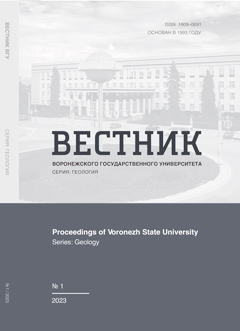Георадиолокационное обследование мостовых сооружений: вопросы методики проведения полевых исследований, обработки и интерпретации материалов. Часть 2 – свайные фундаменты мостовых опор
Аннотация
Введение: Обследование мостовых сооружений (мостов, путепроводов, акведуков, виадуков, эстакад и пр.), которые предназначены для перевода различных коммуникаций, прежде всего – транспортных, через какие-либо препятствия (водные преграды, авто- и железные дороги, овраги и т.п.), имеет целью определение их конструктивных характеристик и технического состояния, от которых зависят как возможность дальнейшего продолжения безаварийной эксплуатации объектов, так и их ремонтопригодность [1]. Конструктивные элементы мостовых сооружений, которые недоступны для непосредственного (прямого) изучения, могут быть обследованы геофизическими методами, прежде всего георадиолокацией [1−7]. Следует отметить, что георадиолокационный метод официально рекомендован для обследования фундаментов опор мостовых сооружений ГОСТ Р 59617-2021 [1]. 1-ая часть статьи была посвящена вопросам георадиолокационного обследования массивных фундаментов мостовых опор [6]. В предлагаемой читателю 2-ой части статьи рассматриваются результаты и некоторые методические вопросы обследования свайных фундаментов, а также таких элементов мостовых сооружений как переходные плиты, подпорные и шкафные стенки. Методика: Статья иллюстрируется авторскими материалами георадиолокационного обследования различных элементов мостовых сооружений, причем, не только фундаментов, но и стоек опор, подпорных и шкафных стенок, переходных плит. Результаты и обсуждение: Материалы, представленные в статье, подтверждают высокую эффективность и универсальность георадиолокационного метода обследования мостовых сооружений, который, во многих случаях, оказывается единственно возможным источником информации о конструктивных характеристиках и техническом состоянии их элементов, расположенных как над, так и под поверхностью земли. Бесконтактный способ возбуждения и измерения электромагнитных по- лей, а также возможность использования экранированных антенных блоков, которые имеют более благоприятную направленность излучения и приема зондирующего электромагнитного излучения, позволяют уменьшить зависимость результативности исследований от условий их проведения. Заключение: Данные обследования мостовых сооружений свидетельствуют о высокой информативности георадиолокационного метода, особенно при изучении погребенных частей сооружений. Возможность выбора методики исследований, их аппаратурного обеспечения и подходов к интерпре- тации материалов позволяют оптимизировать их проведение применительно к решению конкретных задач.
Скачивания
Литература
2. ГОСТ 33179-2014. Дороги автомобильные общего пользования. Изыскания мостов и путепроводов. Общие требования. М.: Стандартинформ, 2014. 36 с.
3. Аузин А. А. Георадиолокационное обследование фундаментов мостовых сооружений // Геотехника. No 6. 2017. С. 58–77.
4. Аузин А. А. Информационные возможности георадиолокационного метода при обследовании строительных объектов // Вестник Воронежского государственного университета. Серия: Геология. 2022. No 2. С. 54–62.
5. Аузин А. А., Зацепин С. А. Георадиолокационное обследование проблемных участков дорожно-транспортной сети // Вестник Воронежского государственного университета. Серия: Геология. 2012. No 2. С. 242–246.
6. Аузин А. А., Каратаев Д. Д. Георадиолокационное обследование мостовых сооружений: вопросы методики проведения полевых исследований, обработки и интерпретации материалов. Часть 1 – массивные фундаменты мостовых опор // Вестник Воронежского государственного университета. Серия: Геология. 2023. No 4. С. 106–112.
7. Старовойтов А. В. Интерпретация георадиолокационных данных. М.: МГУ, 2006. 192 с.
8. Ground Penetrating Radar. 2nd edition. Ed. Daniels D. J. IEE Press, London 2004. 726 р.
9. Ground Penetrating Radar. Theory and Applications. Ed. Jol H.M. Elsevier. Amsterdam. 2009. 544 р.













